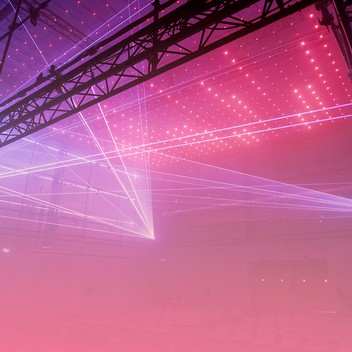Installation
Polytopes 2025

Reading time 5mn
By Jérémie Szpirglas
Revived in 2022 thanks to the digital art studio ExperiensS and IRCAM researcher Pierre Carré, Xenakis’ Polytope is experiencing a new life, once again pushing boundaries. Now, composer, producer, and DJ CHLOE has been commissioned to create a piece specifically for this unique setup. “I am, of course, familiar with Xenakis’ work,” says Chloé. “I wouldn’t claim to know every aspect of his oeuvre, but his multidisciplinary genius remains a major reference in both contemporary music and electronic scenes. What resonates with me most is the way he fuses mathematics with poetry. His approach is precise, rigorously constructed—radical and powerful.”
“When I was first approached for this project, I wasn’t specifically familiar with Polytope, though I had seen videos and a simplified installation at the Xenakis exhibition at the Philharmonie de Paris. What immediately captivated me was its visual dimension—Polytope has a strong architectural component, which instantly spoke to the club and rave culture I come from. It also reminded me of SloMo AV, an ambient project where I create sounds that transform in real-time, interacting with visual elements that morph, slow down, and distort. The difference here? It’s all happening in 360 degrees.”
Reconstitution du Polytopes à l'Espace de projection de l'Ircam, 2022 © Ircam-Centre Pompidou, photo : Quentin Chevrier
For Chloé, this commission is an opportunity to push her compositional experiments further while staying true to her core artistic principles. “In an immersive experience like this, the physical impact of sound frequencies is crucial. But the way this music is received will be very different from what I’m used to—here, the audience will be sitting or lying down, invited on a thirty-minute sonic journey. I plan to begin with textural and atmospheric elements that evolve organically through spectral manipulation. My composition process is intuitive: I build sound libraries, then layer and sculpt them into evolving sonic landscapes.”
As she discusses this new artistic venture, another key figure of 20th-century music comes to mind: Giacinto Scelsi. “I’m a huge fan of Scelsi. What moves me in his music is the way he handles low frequencies—how he introduces them, often with instruments that typically operate in the midrange, and how he lets them evolve. His approach to sound feels almost sculptural. Exploring cross-synthesis between Scelsi and Xenakis might seem audacious, even provocative—but that’s precisely what makes it so compelling.”
When it comes to computer music technology, Chloé is upfront about her background: she’s entirely self-taught. Yet, she works daily with cutting-edge tools, such as Ableton Live and IRCAM’s vast library of software, which has provided her with sonic possibilities unavailable elsewhere. “I’ve used Audiosculpt extensively. I love its visual approach to sound design and manipulation, especially with cross-synthesis techniques that allow me to create hybrid sounds by working with partials extracted from audio analysis. Diving into this tool has been a huge learning experience. As for Max, I wouldn’t call myself an expert, but I often take existing patches and modify them to fit my needs. Since Max for Live was integrated into Ableton Live, I use it frequently.”
Her work at IRCAM presents an opportunity to explore new tools. “I’m collaborating with Pierre Carré, who knows the Polytope better than anyone. He listened to my music, particularly SloMo AV, and suggested various IRCAM technologies for sound design and processing that might suit my approach.”
“We first looked for tools to generate material—especially rich, atmospheric textures. My initial thought was SKataRT, a concatenative synthesis engine integrated into Live, derived from CataRT. It works like granular synthesis: starting from a sound bank, SKataRT slices and rearranges sounds, allowing control over parameters such as pitch, density, and inharmonicity. We also explored Rave, a machine-learning-based synthesis engine developed by IRCAM’s Acids team. The idea is to train an AI model with a set of sounds, which it then uses to resynthesize textures—or even more structured elements—while maintaining the character of the original data.”
However, given the nature of Polytope, spatialization is one of the project’s key challenges. “This is completely new territory for me,” Chloé admits, clearly energized by the challenge. “Spatialization is rare in electronic music performances, so I’ll be using my sessions at IRCAM to experiment with it. But for me, spatialization has to be fully integrated with the sonic elements.”
Pierre Carré elaborates: “The original Polytope used 12 speakers to spatialize 7 audio channels dynamically. In our reconstruction, we expanded the setup to a 25-speaker array, keeping Xenakis’ signature raw aesthetic rather than smoothing out discontinuities. To help Chloé work independently, I introduced her to tools that she can use in her Ableton Live sessions. While they don’t have the full precision and flexibility of IRCAM’s Spat system, they strike a balance between efficiency and ease of use. These tools will allow her to implement her spatialization ideas seamlessly during the performance.”
Photo illustration and in the text: Chloé Thévenin © Alexandre de la Madeleine